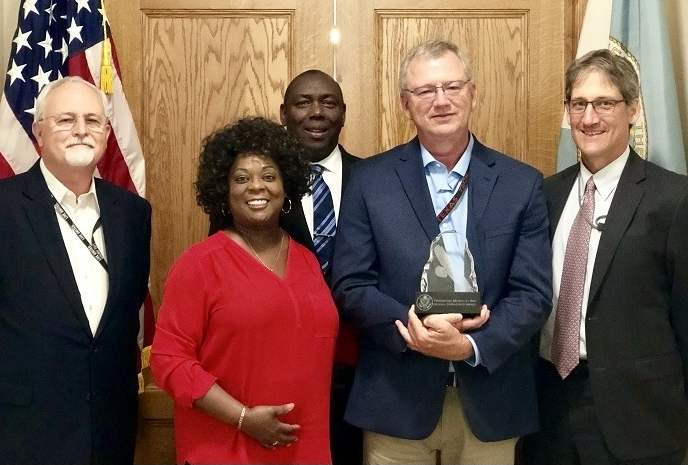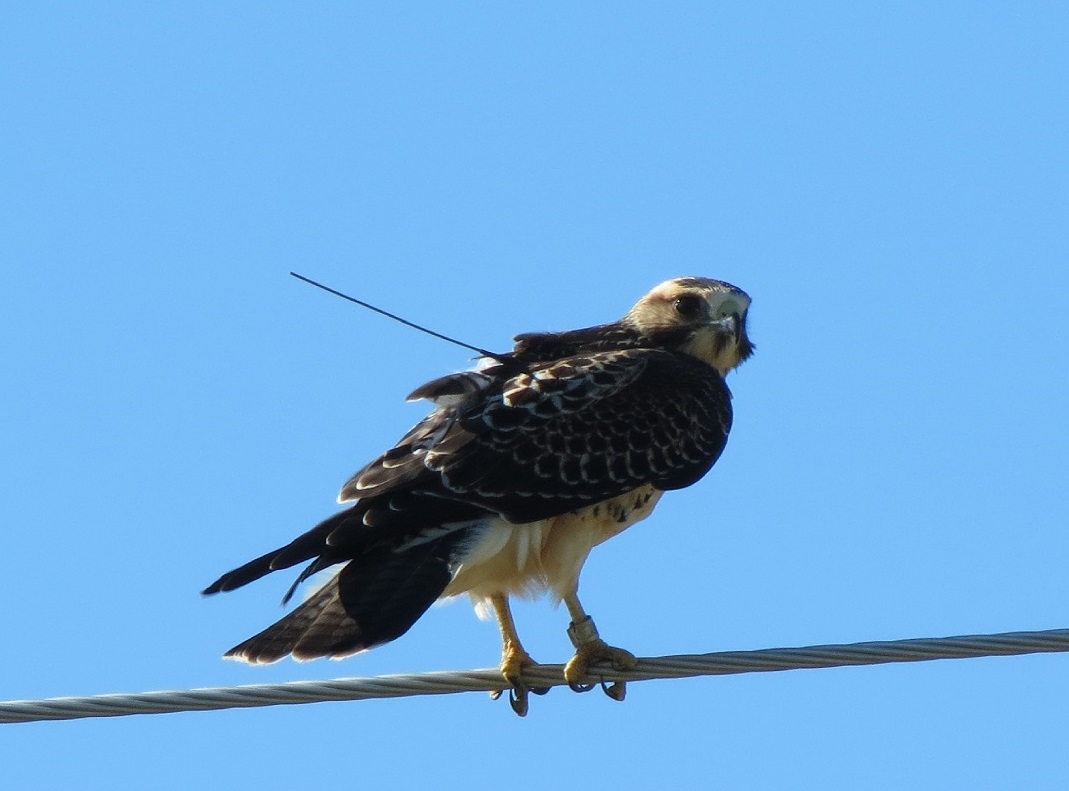2019 Presidential Migratory Bird Stewardship Award Winner
The Council for the Conservation of Migratory Birds is pleased to announce the winner of the 2019 Presidential Migratory Bird Federal Stewardship Award. The U. S. Department of Energy/National Nuclear Security Administration (DOE/NNSA) Pantex Plant was honored at this year’s Council meeting for their innovative work with Swainson’s Hawks, Purple Martins, and other birds across the Western Hemisphere. The Presidential Migratory Bird Federal Stewardship Award annually recognizes a single project or action conducted by or in partnership with a Federal agency that meets the intent and spirit of Executive Order 13186 by focusing on migratory bird conservation.

Award winners. Pictured (from left to right) are Chris Cantwell, DOE/NNSA Pantex Plant; Beverly Whitehead, DOE; Jerome Ford, U.S. Fish & Wildlife Service; James Ray, DOE/NNSA Pantex Plant; and Josh Silverman, DOE. Photo Credit: U.S. Fish and Wildlife Service
About the Winning Project

Project: Pantex-A Multi-Dimensional Approach to Contributing to Migratory Bird Conservation across Hemispheres
Project Lead: Department of Energy /Consolidated Nuclear Security, LLC (Pantex Plant)
Partners: Texas Tech University (including the USGS Texas Cooperative Fish and Wildlife Research Unit), West Texas A&M University, University of Manitoba (Canada), York University (Canada), Purple Martin Conservation Association, Disney World Wide Fund, Texas Parks and Wildlife Department, and many property owners and volunteers.
Description: The Pantex Plant increased its on-going research, collaborations, and outreach programs in 2017 and 2018. Pantex added an additional partner, the Texas Ornithological Society, which donated geolocators to Pantex staff for deployment on Purple Martins.
Pantex sponsored collaborations continued the monitoring of nine species of concern and other birds in plots associated with wind energy research (West Texas A&M University), transitioned the Swainson’s Hawk research to juveniles (Texas Tech University; including the USGS Texas Cooperative Fish and Wildlife Research Unit), and continued with analyses of data gathered on Swainson’s Hawks throughout the Hawk’s annual travels through North, Central and South America. Pantex continued to collaborate with and provide a sixth deployment site for geolocators and G.P.S. data-loggers as part of an international collaboration that has now documented and characterized core stopover regions and durations (Yucatan and Central America) and specific wintering sites of the declining Purple Martin across the Amazon Basin. The collaboration is already visiting roost sites and building relationships with managers and researchers in Brazil.
The Pantex banding and outreach program fostered continued staff participation in a graduate-level class project (Texas Tech University) which has led to a peer-reviewed journal article, the start-up of a legacy Purple Martin housing and research project for the Student Chapter of The Wildlife Society (Texas Tech University), and has now resulted in the banding of more than 12,000 Purple Martins and several publications.
Pantex continued mapping of prairie dog colonies on the facility as part of a management plan that assures preferred prairie dog-manipulated habitat for four previously mentioned special status species, including Western Burrowing Owls. During 2017 and 2018, Pantex collaborations and staff shared findings and management implications from migratory bird projects through 17 technical/conference presentations and posters, four magazine articles, three peer-reviewed journal articles, and two other scholarly articles which are in review or press.
Other agency sites continued to express interest in implementing “the Pantex research model” or collaborating with the site (Las Alamos National Lab, Y-12, Oak Ridge National Lab). As testimony to the success and respect of the Pantex program, there have been three instances of university researchers wanting to include Pantex and staff in applications for grants. Building off the successes of its contributions to migratory bird conservation, Pantex has used this successful model as a springboard for similar collaborations under the national pollinator initiative. Pantex recommendations have led to USDOE/NNSA sponsorship of a Raptor Research Foundation conference and a new purple martin colony at the Amarillo Zoo.
Considering the high-level issues, data collected, shared management implications, and on-site protection strategies, the Pantex partnership may benefit the full suite (442 species) of birds that breed in, migrate through, and winter in the Southern Great Plains. Research plot data include 28 special status species and 26 others have been documented using the site. Multitudes of bird species and individuals fly through, rest, and feed on the Pantex property during migration, and all the while they must navigate through many potential threats and an ever-growing number of wind farms. Students working on projects are graduating well-versed in migratory bird issues and advanced technology. Some, having tracked Swainson’s Hawks and Purple Martins across the Americas have already contributed to migratory bird conservation of hemispheric or global significance.
Full article can be found on the US Fish and Wildlife website.
